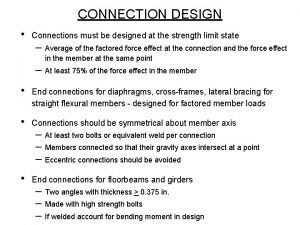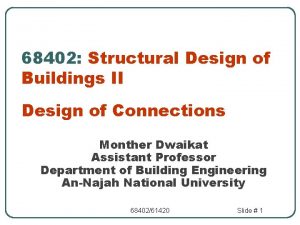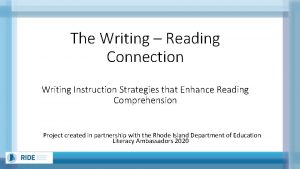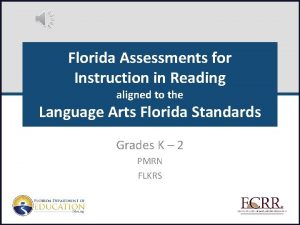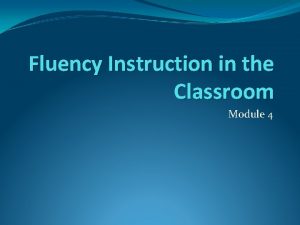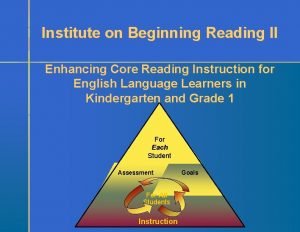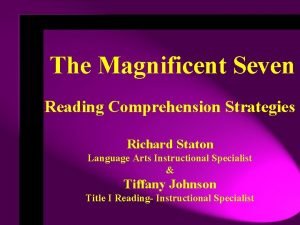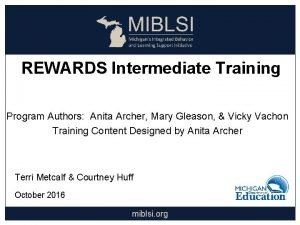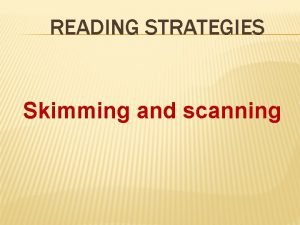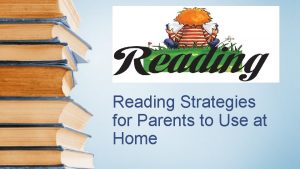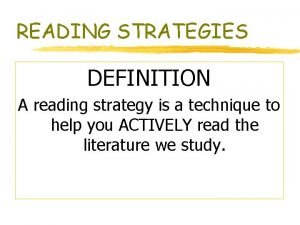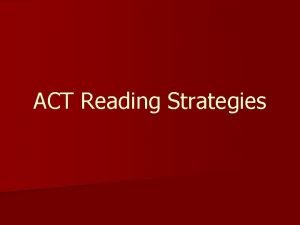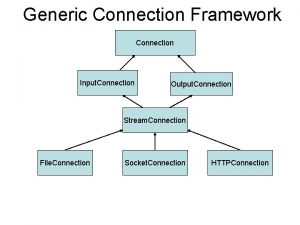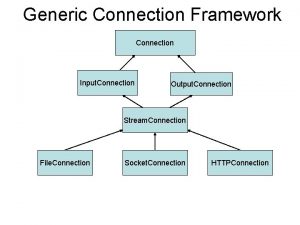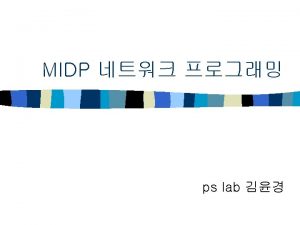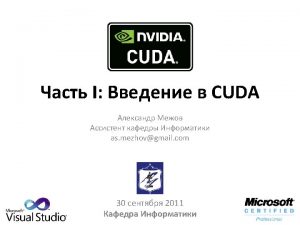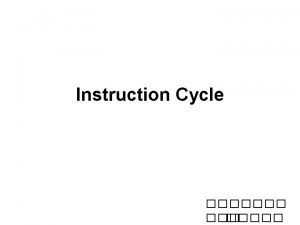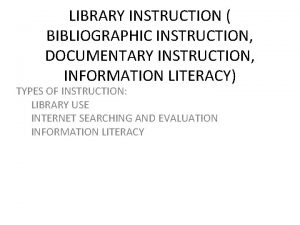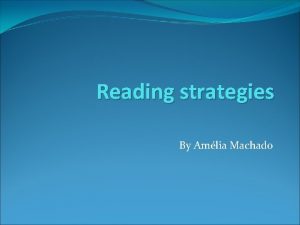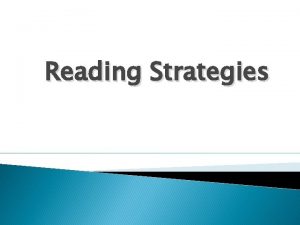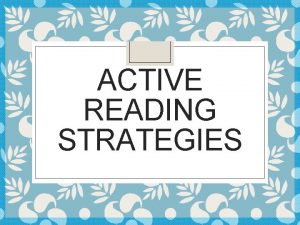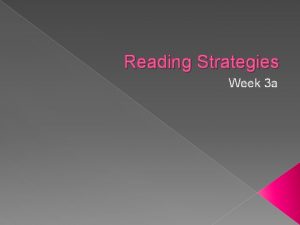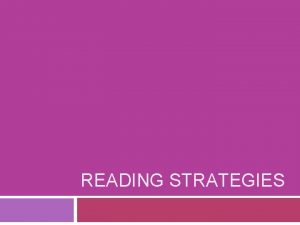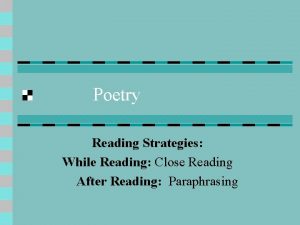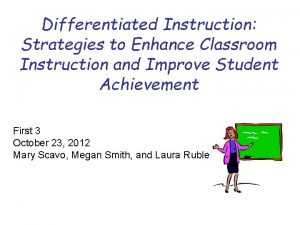The Writing Reading Connection Writing Instruction Strategies that































- Slides: 31

The Writing – Reading Connection Writing Instruction Strategies that Enhance Reading Comprehension Project created in partnership with the Rhode Island Department of Education Literacy Ambassadors 2020

During this presentation, participants will: • Use the Simple View of Writing as an organizing framework for writing instruction • Discover The Writing Revolution (TWR) resource for teaching writing • Watch a TWR video explaining because, but, so sentence expansion as one example out of many presented in TWR. • Practice because, but, so sentence expansion. • Develop an understanding of why explicit instruction in sentence structure is an important part of developing literacy skills

Why is writing hard to teach? • Take a few minutes to write down 2 -3 things that make teaching writing challenging in your classroom? • Turn and share with a table partner/ or type into chat feature.

What do we mean by "Written Expression"? Written expression instruction includes: • the mechanics and conventions of writing, • composition (handwriting, spelling, punctuation, syntax), • semantics, • as well as the phases of the writing process (composition, revision, and editing). (International Dyslexia Association)


Writing Instruction is Reciprocal with Reading Comprehension Abilities "As students learn to employ more complex sentences in their oral and written language, their ability to make sense of what they read increases, too. " – Timothy Shanahan

The Writing Revolution - TWR • Transform how you teach writing…right away! • Help students use more precise language when they summarize their reading. • Provide academic language development while writing about content.

Six Principles of Writing Instruction outlined in The Writing Revolution: • Students need explicit instruction in writing, beginning in the early elementary grades. • Sentences are the building blocks of all writing. • When embedded in the content of the curriculum, writing instruction is a powerful teaching tool. • The content of the curriculum drives the rigor of the writing activities. • Grammar is best taught in the context of student writing. • The two most important phases of the writing process are planning and revising.

TWR Principle # 1: Students need explicit instruction in writing, beginning in the early elementary grades. Teaching strategies Framework for organizing effective, explicit instruction.

TWR Principle # 2: Sentences are the building blocks of all writing. • Text Generation is part of Simple View of Writing (SVW) • Good writing often involves more complex sentence structures and a more varied and precise vocabulary than spoken language. • A writer who can’t compose a decent sentence most likely will not produce a decent essay—or even a decent paragraph.

TWR Principle # 3: When embedded in the content of the curriculum, writing is a powerful teaching tool. • To maximize the benefits of writing instruction, students should start practicing their writing skills on topics embedded in content as soon as possible. (Hochman). • Teachers can use writing as a check for comprehension.

TWR Principle # 4: When embedded in the content of the curriculum, writing is a powerful teaching tool. • Students can learn simple writing strategies that can be applied to all content areas. • The form of the activity will stay the same, but the content is what makes it more or less rigorous.

TWR Principle # 5: Grammar is best taught in the context of student writing • Teachers should refer to CCSS Language Standards in addition to the CCSS Writing Standards when planning instruction. • As students begin to use more complex terms and sentence constructions in their written language, they begin to incorporate those features into their spoken language as well.

TWR Principle # 6: The two most important phases of the writing process are planning and revising. The Simple View of Writing reminds us that the planning and revising phases of the writing process are located in “Executive Functions. ”

A Focus on TWR Principle # 4 • Let’s examine a high-leverage sentence-level strategy focused on the use of the conjunctions because, but, and so to better understand what is meant by TWR Principle #4: the content of the curriculum drives the rigor of the writing activities.

Because, but, so. . . Co-Executive Directors of The Writing Revolution, Toni-Ann Vroom and Dina Zoleo, discuss the because, but, and so strategy.

TWR Principle # 4 Elementary ELA Example: If you’re teaching elementary students, you might give them this stem: Rocket learned to read ________________. You’ll ask the students to complete the stem with a phrase beginning with because, but, and, or so. They might respond: Rocket learned to read because ________. Rocket learned to read, but__________. Rocket learned to read, so___________.

TWR Principle # 4 Elementary ELA Example: If you’re teaching elementary students, you might give them this stem: Rocket learned to read ________________. You’ll ask the students to complete the stem with a phrase beginning with because, but, and, or so. They might respond: Rocket learned to read because the yellow bird taught him. Rocket learned to read, but at first he was bored. Rocket learned to read, so he was proud of himself.

TWR Principle # 4 Writing in Mathematics Example In mathematics, instead of asking, “What is a fraction? , ” you can give your students this stem: Fractions are like decimals _______________. They might complete it like this: Fractions are like decimals because _______. Fractions are like decimals, but _________. Fractions are like decimals, so_________.

TWR Principle # 4 Writing in Mathematics Example In mathematics, instead of asking, “What is a fraction? , ” you can give your students this stem: Fractions are like decimals _______________. They might complete it like this: Fractions are like decimals because they are all parts of wholes. Fractions are like decimals, but they are written differently. Fractions are like decimals, so they can be used interchangeably.

Why is explicit instruction of sentence structure an important part of developing literacy skills?


Analyzing Student Writing Analyze student writing samples and spelling tests to refine instructional targets (e. g. , development of phonological awareness, knowledge of spelling rules, awareness of inflectional morphemes). International Dyslexia Association Knowledge and Practice Standards. Student writing also yields information on syntax, composition, organization, comprehension, and handwriting. Error Analysis

Deliberate Practice Students need plenty of opportunities to practice writing skills. Sentence composing: • Is manageable for teachers and students • Works well in small group instruction

Feedback is important and nourishes student learning • Students need feedback provided in a timely manner, with suggestions targeted toward improvement. • Feedback is best when given during instructional time, such as in a writing conference or small group.

Resources and Activities for GOING FURTHER

The Writing Revolution ●The Writing Revolution is a great text for PLC study ●Multiple strategies included to help students with notetaking, summarizing, sentence combining, grammar in context, single and multiple paragraph outlining ●Great companion text to study alongside The Knowledge Gap, by Natalie Wexler

The Writing Revolution Writing Principles #2 and #5 in Action: Sentence Expansion Sentence Combining https: //vimeo. com/208687154 • https: //vimeo. com/207849027

To provide a stronger understanding of the breadth and depth of TWR, here are topics covered in the Table of Contents from the book, The Writing Revolution: 1 Sentences: The Basic Building Blocks of Writing 23 2 Sentence Expansion and Note-Taking: Getting Students to Process What They’ve Read 55 3 One Step at a Time: Why Students Need to Plan Before They Write 69 4 First Steps in Planning: The Single-Paragraph Outline 83 5 Putting Flesh on the Bones: Revising a Draft 111 6 Summarizing: Mining Texts for the Essentials 138 7 Moving on to Compositions: The Multiple-Paragraph Outline 152 8 Take a Stand: Writing Opinion, Pro-Con, and Argumentative Essays 179 9 A Gauge and a Guide: Assessing Students’ Writing 204 10 Putting the Revolution Into Practice: Combining Our Sequence With Your Judgment 218

More sentence level resources There a number of good resources for teachers to integrate sentence instruction into the curriculum. These are just a few (click on image for link):

Wrap Up 3 -2 -1 Strategy Exit Slip 3 things you learned from today’s presentation 2 ideas you will try in your classroom 1 question you still have
 Slip critical connection vs bearing connection
Slip critical connection vs bearing connection A325sc bolt
A325sc bolt Slip critical bolted connection
Slip critical bolted connection Connection in literature
Connection in literature Phân độ lown
Phân độ lown Block xoang nhĩ
Block xoang nhĩ Thể thơ truyền thống
Thể thơ truyền thống Thơ thất ngôn tứ tuyệt đường luật
Thơ thất ngôn tứ tuyệt đường luật Chiến lược kinh doanh quốc tế của walmart
Chiến lược kinh doanh quốc tế của walmart Tìm vết của đường thẳng
Tìm vết của đường thẳng Hãy nói thật ít để làm được nhiều
Hãy nói thật ít để làm được nhiều Tôn thất thuyết là ai
Tôn thất thuyết là ai Gây tê cơ vuông thắt lưng
Gây tê cơ vuông thắt lưng Sau thất bại ở hồ điển triệt
Sau thất bại ở hồ điển triệt Pre reading while reading and post reading activities
Pre reading while reading and post reading activities Differentiated instruction vs individualized instruction
Differentiated instruction vs individualized instruction Direct vs indirect instruction
Direct vs indirect instruction The reading connection
The reading connection Florida assessment for instruction in reading
Florida assessment for instruction in reading Fluency oriented reading instruction
Fluency oriented reading instruction Enhanced core reading instruction
Enhanced core reading instruction 7 comprehension strategies
7 comprehension strategies Anita archer training
Anita archer training What is scanning ?
What is scanning ? Reading strategies for parents
Reading strategies for parents Read strategy definition
Read strategy definition While reading stage
While reading stage Super 6 reading strategies
Super 6 reading strategies Nonfiction reading strategies
Nonfiction reading strategies Types of reading skill
Types of reading skill Example of active reading
Example of active reading Act reading strategies
Act reading strategies
